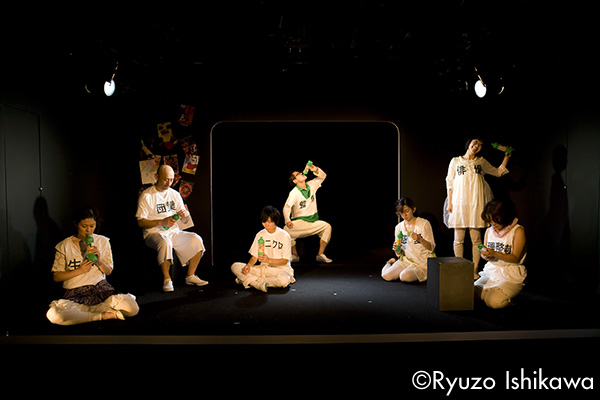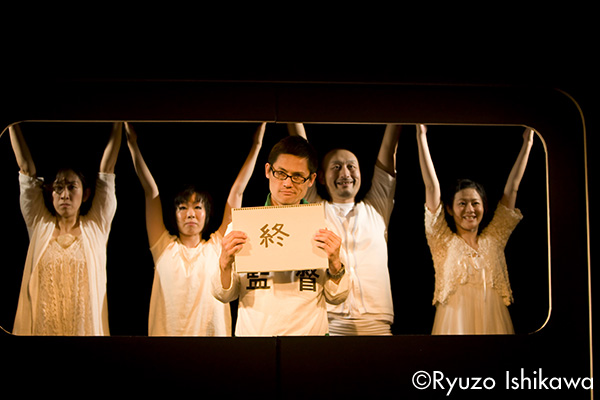

Kyokuto-taikutsu-dojo production
Subway
Photo: Ryuzo Ishikawa
Data
:
Premiere: 2010
Length: 1 hr. 45 min.
Acts/scenes: 1 act, 8 scenes
Cast: 7 (3 men, 4 women)
Subway

Born 1977 in Hakodate, Hokkaido, Japan, Shinichiro Hayashi is a playwright and director. While a student at Kyoto University, he joined in the founding of Misada Produce theater company and began activities in theater. Since then he has been active as a playwright and director for the company under the artist name of Shinichi Misada. From 2004, he studied playwriting under So Kitamura at the Itami So-ryu Private School. In 2007, Hayashi ended his activities with his theater company and began activities anew under his real name, Shinichiro Hayashi, engaging in private productions gathering actors separately for each production under the company name “Kyokuto Taikutsu Dojo.” In his plays he attempts to use a noisy “pointillist” sketch style of depiction of people living in the urban environment in order to create images of floating “contemporary cities.” Among his representative plays are Yoru ni Ukabete Re:Build (2004 premiere / Misada Produce), a play that takes what is apparently the night landscape of Hakodate as its backdrop and presents conversations that arise and fade away in passing gondola cars over the course of several winters; Subway , a play composed of pointillist sketches of urban residents who come aboard the subway cars; and Times , a play that presents manic clippings of contemporary life using the device of coin-parking lots, for which he has been awarded the Grand Prize of the 18th OMS Drama Awards and the Special Mention Award of the 20th OMS Drama Awards. This plat PORTAL was selected as a finalist for the 61st Kishida Drama Awards (2016).
Kyokuto Taikutsu Dojo
http://taikutsu.info/


Kyokuto-taikutsu-dojo production
Subway
Photo: Ryuzo Ishikawa
Data
:
Premiere: 2010
Length: 1 hr. 45 min.
Acts/scenes: 1 act, 8 scenes
Cast: 7 (3 men, 4 women)
A film director named Hiverly Chan has just staged the grand release of her newest film, a documentary titled
Shock of the Armed White-collar Workers
. The film portrays an unlikely but nonetheless shocking scenario in which the white-collar workers riding Japan’s subways are trained to respond to a certain “sound” that is broadcast in the subways and convert en masse into soldiers when an emergency arises.
The director interviews seven people who commute by subway, including an insurance company employee, a university student, an elementary school teacher, a nurse, a part-timer, a “Padonna” (a woman who hands out copies of the advertising magazine
Pado
) and a librarian. Each is asked how they use the subways, and when they speak in detail about the almost unbearably harsh conditions of their lives, we begin to get a picture of the realities of this working generation. We also learn that some of them have already become aware of something that appears to be that distinct “sound” in the subways.
The interviews of the seven people become long monologue scenes that take the form of an account of the seven days of creation (Genesis) interspersed with elements from the personal time and lives of the seven. The resulting accounts reveal points of connection between the lives of what were supposedly seven unrelated individuals. The university student Hashi, who wants to become a DJ, is having a relationship with the elementary school teacher Yamamura, and in the past Hashi once happened to steal the bicycle of the nurse, Mifune. When the insurance company employee Yashiro visits the “Padonna” Sera after an accident, it turns out that the nurse taking care of Sera is a colleague of the nurse Mifune. There are also coincidental links like the fact that the part-timer Sato and the Padonna Sera happen to be looking for the same video at the video rental shop Tsutaya.
Although they represent a random cross-section of society and are of different ages, genders and walks of life, they still have certain things in common. The biggest point in common is that they all live in the metropolis far from their family homes.
As the line becomes blurred between what are scenes from the movie and what is reality, a picture of typical postwar Japanese families that have lost their hometown roots emerges.
The scene shifts to a town in the north. There is a son named Minoru who wants to make a living as a singer and his old-fashioned parents who want to stop him from such a rootless life. Minoru later changes his name to Saburo Kitajima and becomes a nationally famous singer and mainstay of the annual New Year’s
Kohaku
(Red and White) song gala on the national television network. His most famous song is
Matsuri
(Festival), a standard known by all Japanese. When Saburo sings
Matsuri
, the White (men’s) team almost always wins over the Red (women’s) team in the
Kohaku
songfest.
Matsuri
is a song of victory, and the proposition is that when absorbed in the spirit of the festival (
matsuri
), the Japanese become invincible. The movie director Hiverly Chan claims to have discovered that the “sound” being broadcast in the subways is this
Matsuri
and that the word “subway” (pronounced
sa-bu-way
in Japanese) can be read as “the way to Sabu[ro].” The director goes on to claim that in case of an invasion of Earth by aliens from outer space, the carefully trained Japanese white-collar workers will rally to the sound of
Matsuri
to save our world.
Of course, this is all fiction. But, the director claims that fiction is the true reality and that reality exists for the sake of fiction. However, it turns out that the director may actually be hospitalized at present and, in fact, no one knows what is actually reality anymore.
Look to the left or to the right from the subway platform and there is only darkness. There are no landscapes to be seen. The hometowns in the minds of the people may never have actually existed after all. One thing for certain is that the subway trains always arrive at their destinations. What are the destinations our realities are leading us toward?
Related Tags